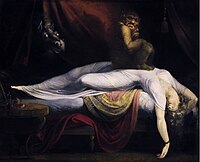Romanticism: Difference between revisions
Salluminium (talk | contribs) m The location of John Martin's 'The destruction of Soddom and Gomorrah' (1852) added as being at the Laing Art Gallery, Newcastle upon Tyne, England, UK. |
No edit summary |
||
| Line 1: | Line 1: | ||
that pic sucks |
|||
[[Image:Caspar David Friedrich 032.jpg|thumb|right|300px|[[Caspar David Friedrich]], ''[[Wanderer above the Sea of Fog]],'' 38.58 × 29.13 inches, 1818, Oil on canvas, [[Kunsthalle Hamburg]]]] |
[[Image:Caspar David Friedrich 032.jpg|thumb|right|300px|[[Caspar David Friedrich]], ''[[Wanderer above the Sea of Fog]],'' 38.58 × 29.13 inches, 1818, Oil on canvas, [[Kunsthalle Hamburg]]]] |
||
{{Otheruses|Romance}} |
{{Otheruses|Romance}} |
||
Revision as of 14:49, 20 April 2010
that pic sucks

Romanticism is a complex artistic, literary, and intellectual movement that originated in the second half of the 18th century in Western Europe, and gained strength in reaction to the Industrial Revolution.[1] In part, it was a revolt against aristocratic social and political norms of the Age of Enlightenment and a reaction against the scientific rationalization of nature,[2] and was embodied most strongly in the visual arts, music, and literature, but had a major impact on historiography[3], education[4] and natural history.[5]
The movement validated strong emotion as an authentic source of aesthetic experience, placing new emphasis on such emotions as trepidation, horror and terror and awe—especially that which is experienced in confronting the sublimity of untamed nature and its picturesque qualities, both new aesthetic categories. It elevated folk art and ancient custom to something noble, made of spontaneity a desirable character (as in the musical impromptu), and argued for a "natural" epistemology of human activities as conditioned by nature in the form of language and customary usage.
Romanticism reached beyond the rational and Classicist ideal models to elevate a revived medievalism and elements of art and narrative perceived to be authentically medieval, in an attempt to escape the confines of population growth, urban sprawl, and industrialism, and it also attempted to embrace the exotic, unfamiliar, and distant in modes more authentic than Rococo chinoiserie, harnessing the power of the imagination to envision and to escape.
The modern sense of a romantic character may be expressed in Byronic ideals of a gifted, perhaps misunderstood loner, creatively following the dictates of his inspiration rather than the mores of contemporary society.
Although the movement is rooted in the German Sturm und Drang movement, which prized intuition and emotion over Enlightenment rationalism, the ideologies and events of the French Revolution laid the background from which both Romanticism and the Counter-Enlightenment emerged. The confines of the Industrial Revolution also had their influence on Romanticism, which was in part an escape from modern realities; indeed, in the second half of the 19th century, "Realism" was offered as a polarized opposite to Romanticism.[6] Romanticism elevated the achievements of what it perceived as heroic individualists and artists, whose pioneering examples would elevate society. It also legitimized the individual imagination as a critical authority, which permitted freedom from classical notions of form in art. There was a strong recourse to historical and natural inevitability, a zeitgeist, in the representation of its ideas.
Characteristics
In a basic sense, the term "Romanticism" has been used to refer to certain artists, poets, writers, musicians, as well as political, philosophical and social thinkers of the late 18th and early to mid 19th centuries. It has equally been used to refer to various artistic, intellectual, and social trends of that era. Despite this general usage of the term, a precise characterization and specific definition of Romanticism have been the subject of debate in the fields of intellectual history and literary history throughout the twentieth century, without any great measure of consensus emerging. Arthur Lovejoy attempted to demonstrate the difficulty of this problem in his seminal article "On The Discrimination of Romanticisms" in his Essays in the History of Ideas (1948); some scholars see romanticism as essentially continuous with the present, some see in it the inaugural moment of modernity, some see it as the beginning of a tradition of resistance to Enlightenment rationalism—a Counter-Enlightenment—and still others place it firmly in the direct aftermath of the French Revolution. An earlier definition comes from Charles Baudelaire: "Romanticism is precisely situated neither in choice of subject nor exact truth, but in the way of feeling."[7]
Many intellectual historians have seen Romanticism as a key movement in the Counter-Enlightenment, a reaction against the Age of Enlightenment. Whereas the thinkers of the Enlightenment emphasized the primacy of deductive reason, Romanticism emphasized intuition, imagination, and feeling, to a point that has led to some Romantic thinkers being accused of irrationalism.
Romanticism and music

Ludwig van Beethoven
Although the term "Romanticism" when applied to music has come to imply the period roughly from the 1820s until around 1900, the contemporary application of 'romantic' to music did not coincide with this modern interpretation. In 1810 E.T.A. Hoffmann called Mozart, Haydn and Beethoven the three "Romantic Composers", and Ludwig Spohr used the term "good Romantic style" to apply to parts of Beethoven's Fifth Symphony. Technically, Mozart and Haydn are considered Classical composers, and by most standards, Beethoven represents the start of the musical Romantic period. By the early twentieth century, the sense that there had been a decisive break with the musical past led to the establishment of the nineteenth century as "The Romantic Era," and it is referred to as such in the standard encyclopedias of music.
The traditional modern discussion of the music of Romanticism includes elements, such as the growing use of folk music, which are also directly related to the broader current of Romantic nationalism in the arts[8] as well as aspects already present in eighteenth-century music, such as the cantabile accompanied melody[9] to which Romantic composers beginning with Franz Schubert applied restless key modulations.
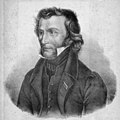
The heightened contrasts and emotions of Sturm und Drang (German for "Storm and Stress") seem a precursor of the Gothic novel in literature, or the sanguinary elements of some of the operas of the period of the French Revolution. The libretti of Lorenzo da Ponte for Mozart's eloquent music convey a new sense of individuality and freedom. The romantic generation viewed Beethoven as their ideal of a heroic artist—a man who first dedicated a symphony to Consul Bonaparte as a champion of freedom and then challenged Emperor Napoleon by striking him out from the dedication of the Eroica Symphony. In Beethoven's Fidelio he creates the apotheosis of the 'rescue operas' which were another feature of French musical culture during the revolutionary period, in order to hymn the freedom which underlay the thinking of all radical artists in the years of hope after the Congress of Vienna.

In the contemporary music culture, the romantic musician followed a public career, depending on sensitive middle-class audiences rather than on a courtly patron, as had been the case with earlier musicians and composers. Public persona characterized a new generation of virtuosi who made their way as soloists, epitomized in the concert tours of Paganini and Liszt.
Beethoven's use of tonal architecture in such a way as to allow significant expansion of musical forms and structures was immediately recognized as bringing a new dimension to music. His later piano music and string quartets, especially, showed the way to a completely unexplored musical universe. E.T.A. Hoffmann was able to write of the supremacy of instrumental music over vocal music in expressiveness, a concept which would previously have been regarded as absurd. Hoffmann himself, as a practitioner both of music and literature, encouraged the notion of music as 'programmatic' or narrative, an idea which new audiences found attractive. Early nineteenth century developments in instrumental technology—iron frames for pianos, wound metal strings for string instruments—enabled louder dynamics, more varied tone colours, and the potential for sensational virtuosity. Such developments swelled the length of pieces, introduced programmatic titles, and created new genres such as the free-standing concert overture or tone poem, the piano fantasia, nocturne and rhapsody, and the virtuosic concerto, which became central to musical romanticism.
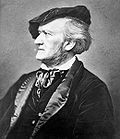
In opera, a new Romantic atmosphere combining supernatural terror and melodramatic plot in a folkloric context was first successfully achieved by Weber's Der Freischütz (1817, revised 1821). Enriched timbre and color marked the early orchestration of Hector Berlioz in France, and the grand operas of Meyerbeer. Amongst the radical fringe of what became mockingly characterised (adopting Wagner's own words) as 'artists of the future', Liszt and Wagner each embodied the Romantic cult of the free, inspired, charismatic, perhaps ruthlessly unconventional individual artistic personality.
The Romantic-era ballet freed itself both from opera, in which a ballet interlude retained an essential role only in Paris, and from court fêtes, and independently paralleled the developments of opera with explicit narrative libretti, expressed in lengthy passages of mime, the universal presence of impetuous or ill-fated young love, the supremacy of the ballerina and the choice often of supernatural subjects: Giselle (1841) remains the supreme example.
It is the period of 1815 to 1848 which must be regarded as the true age of Romanticism in music – the age of the last compositions of Beethoven (d. 1827) and Schubert (d. 1828), of the works of Schumann (d. 1856) and Chopin (d.1849), of the early struggles of Berlioz and Richard Wagner, of the great virtuosi such as Paganini (d. 1840), and the young Liszt and Thalberg. Now that we are able to listen to the work of Mendelssohn (d. 1847) stripped of the Biedermeier reputation unfairly attached to it, he can also be placed in this more appropriate context. After this period, with Chopin and Paganini dead, Liszt retired from the concert platform at a minor German court, Wagner effectively in exile until he obtained royal patronage in Bavaria, and Berlioz still struggling with the bourgeois liberalism which all but smothered radical artistic endeavour in Europe, Romanticism in music was surely past its prime—giving way, rather, to the period of musical romantics. (See article Romantic music).
Romantic literature

In literature, Romanticism found recurrent themes in the evocation or criticism of the past, the cult of "sensibility" with its emphasis on women and children, the heroic isolation of the artist or narrator, and respect for a new, wilder, untrammeled and "pure" nature. Furthermore, several romantic authors, such as Edgar Allan Poe and Nathaniel Hawthorne, based their writings on the supernatural/occult and human psychology. Romanticism also helped in the emergence of new ideas and in the process led to the emergence of positive voices that were beneficial for the marginalized sections of the society.
The Scottish poet James Macpherson influenced the early development of Romanticism with the international success of his Ossian cycle of poems published in 1762, inspiring both Goethe and the young Walter Scott.
An early German influence came from Johann Wolfgang von Goethe, whose 1774 novel The Sorrows of Young Werther had young men throughout Europe emulating its protagonist, a young artist with a very sensitive and passionate temperament. At that time Germany was a multitude of small separate states, and Goethe's works would have a seminal influence in developing a unifying sense of nationalism. Another philosophic influence came from the German idealism of Johann Gottlieb Fichte and Friedrich Schelling, making Jena (where Fichte lived, as well as Schelling, Hegel, Schiller and the brothers Schlegel) a center for early German romanticism ("Jenaer Romantik"). Important writers were Ludwig Tieck, Novalis (Heinrich von Ofterdingen, 1799), Heinrich von Kleist and Friedrich Hoelderlin. Heidelberg later became a center of German romanticism, where writers and poets such as Clemens Brentano, Achim von Arnim, and Joseph Freiherr von Eichendorff met regularly in literary circles. Important motifs in German Romanticism are travelling, nature, and ancient myths. The later German Romanticism of, for example, E. T. A. Hoffmann's Der Sandmann (The Sandman), 1817, and Joseph Freiherr von Eichendorff's Das Marmorbild (The Marble Statue), 1819, was darker in its motifs and has gothic elements.

In Spain, the Romantic movement developed a well-known literature with a huge variety of poets and playwrights. The most important Spanish poet during this movement was José de Espronceda. After him there were other poets like Gustavo Adolfo Bécquer, Mariano José de Larra and the dramatist José Zorrilla, author of Don Juan Tenorio. Before them may be mentioned the pre-romantics José Cadalso and Manuel José Quintana.
Spanish Romanticism also influenced regional literatures. For example, in Catalonia and in Galicia there was a national boom of writers in the local languages, like the Catalan Jacint Verdaguer and the Galician Rosalía de Castro, the main figures of the national revivalist movements Renaixença and Rexurdimento, respectively.
Brazilian Romanticism is characterized and divided in three different periods. The first one is basically focused in the creation of a sense of national identity, using the ideal of the heroic Indian. Some examples include José de Alencar, who wrote "Iracema" and "O Guarani", and Gonçalves Dias, renowned by the poem "Canção do Exílio" (Song of the Exile). The second period is marked by a profound influence of European themes and traditions, involving the melancholy, sadness and despair related to unobtainable love. Goethe and Lord Byron are commonly quoted in these works. The third cycle is marked by social poetry, especially the abolitionist movement; the greatest writer of this period is Castro Alves.
Romanticism in British literature developed in a different form slightly later, mostly associated with the poets William Wordsworth and Samuel Taylor Coleridge, whose co-authored book Lyrical Ballads (1798) sought to reject Augustan poetry in favour of more direct speech derived from folk traditions. Both poets were also involved in utopian social thought in the wake of the French Revolution. The poet and painter William Blake is the most extreme example of the Romantic sensibility in Britain, epitomised by his claim “I must create a system or be enslaved by another man's.” Blake's artistic work is also strongly influenced by Medieval illuminated books. The painters J. M. W. Turner and John Constable are also generally associated with Romanticism. Lord Byron, Percy Bysshe Shelley, Mary Shelley and John Keats constitute another phase of Romanticism in Britain.
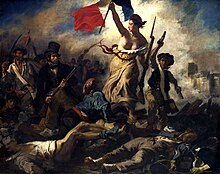
In predominantly Roman Catholic countries Romanticism was less pronounced than in Germany and Britain, and tended to develop later, after the rise of Napoleon. François-René de Chateaubriand is often called the "Father of French Romanticism". In France, the movement is associated with the nineteenth century, particularly in the paintings of Théodore Géricault and Eugène Delacroix, the plays, poems and novels of Victor Hugo (such as Les Misérables and Ninety-Three), and the novels of Stendhal.
Modern Portuguese poetry definitely develops its outstanding character from the work of its Romantic epitome, Almeida Garrett, a very prolific writer who helped shape the genre with the masterpiece Folhas Caídas (1853). This late arrival of a truly personal Romantic style would linger on to the beginning of the 20th century, notably through the works of poets such as Cesário Verde and António Nobre, segueing seamlessly to Modernism. However, an early Portuguese expression of Romanticism is found already in the genius of Manuel Maria Barbosa du Bocage, especially in his sonnets dated at the end of the 18th century.
In Russia, the principal exponent of Romanticism is Alexander Pushkin. Mikhail Lermontov attempted to analyse and bring to light the deepest reasons for the Romantic idea of metaphysical discontent with society and self, and was much influenced by Lord Byron. The poet Fyodor Tyutchev was also an important figure of the movement in Russia, and was heavily influenced by the German Romantics.

In the United States, romantic Gothic literature made an early appearance with Washington Irving's The Legend of Sleepy Hollow (1820) and Rip Van Winkle (1819), followed from 1823 onwards by the Leatherstocking Tales of James Fenimore Cooper, with their emphasis on heroic simplicity and their fervent landscape descriptions of an already-exotic mythicized frontier peopled by "noble savages", similar to the philosophical theory of Rousseau, exemplified by Uncas, from The Last of the Mohicans. There are picturesque "local color" elements in Washington Irving's essays and especially his travel books. Edgar Allan Poe's tales of the macabre and his balladic poetry were more influential in France than at home, but the romantic American novel developed fully in Nathaniel Hawthorne's atmosphere and melodrama. Later Transcendentalist writers such as Henry David Thoreau and Ralph Waldo Emerson still show elements of its influence and imagination, as does the romantic realism of Walt Whitman. But by the 1880s, psychological and social realism was competing with romanticism in the novel. The poetry of Emily Dickinson—nearly unread in her own time—and Herman Melville's novel Moby-Dick can be taken as epitomes of American Romantic literature.
Influence of European Romanticism on American writers
The European Romantic movement reached America in the early nineteenth century. American Romanticism was just as multifaceted and individualistic as it was in Europe.[citation needed]
...Romantics frequently shared certain general characteristics: moral enthusiasm, faith in the value of individualism and intuitive perception, and a presumption that the natural world is a source of goodness and human society a source of corruption.[citation needed]
Romanticism became popular in American politics, philosophy and art. The movement appealed to the revolutionary spirit of America as well as to those longing to break free of the strict religious traditions of early settlement. The Romantics rejected rationalism and religious intellect. It appealed to those in opposition of Calvinism, which involved the belief that the universe and all the events within it are subject to the power of God. The Romantic movement gave rise to New England Transcendentalism which portrayed a less restrictive relationship between God and Universe. The new religion presented the individual with a more personal relationship with God. Transcendentalism and Romanticism appealed to Americans in a similar fashion.
As a moral philosophy, transcendentalism was neither logical nor systemized. It exalted feeling over reason, individual expression over the restraints of law and custom. It appealed to those who disdained the harsh God of their Puritan ancestors, and it appealed to those who scorned the pale deity of New England Unitarianism....[]...They spoke for cultural rejuvenation and against the materialism of American society. They believed in the transcendence of the "Oversoul", an all-pervading power for goodness from which all things come and of which all things are parts.[citation needed]
American Romance embraced the individual and rebelled against the confinement of neoclassicism and religious tradition. The Romantic movement in America created a new literary genre that continues to influence modern writers. Novels, short stories, and poems began to take the place of the sermons and manifestos that were associated with the early American literary principals. Romantic literature was personal, intense, and portrayed more emotion than ever seen in neoclassical literature. America's preoccupation with freedom became a great source of motivation for Romantic writers as many were delighted in free expression and emotion without so much fear of ridicule and controversy. They also put more effort into the psychological development of their characters. "Heroes and heroines exhibited extremes of sensitivity and excitement"[citation needed]
Romantic visual arts
In European painting, led by a new generation of the French school,[10] the Romantic sensibility contrasted with the neoclassicism being taught in the academies. In a revived clash between color and design, the expressiveness and mood of color, as in works of J.M.W. Turner, Francisco Goya, Théodore Géricault and Eugène Delacroix, emphasized in the new prominence of the brushstroke and impasto the artist's free handling of paint, which tended to be repressed in neoclassicism under a self-effacing finish. As in England with J.M.W. Turner and Samuel Palmer, Germany with Caspar David Friedrich, Norway with J.C. Dahl and Hans Gude, Spain with Francisco Goya, and France with Théodore Géricault, Eugène Delacroix, Théodore Chassériau, and others; literary Romanticism had its counterpart in the American visual arts, most especially in the exaltation of an untamed American landscape found in the paintings of the Hudson River School. Painters like Thomas Cole, Albert Bierstadt and Frederic Edwin Church and others often expressed Romantic themes in their paintings. They sometimes depicted ancient ruins of the old world, such as in Fredric Edwin Church’s piece Sunrise in Syria. These works reflected the Gothic feelings of death and decay. They also show the Romantic ideal that Nature is powerful and will eventually overcome the transient creations of men. More often, they worked to distinguish themselves from their European counterparts by depicting uniquely American scenes and landscapes. This idea of an American identity in the art world is reflected in W. C. Bryant’s poem, To Cole, the Painter, Departing for Europe, where Bryant encourages Cole to remember the powerful scenes that can only be found in America. This poem also shows the tight connection that existed between the literary and visual artists of the Romantic Era.[citation needed]
Some American paintings promote the literary idea of the “noble savage” (Such as Albert Bierstadt’s The Rocky Mountains, Landers Peak) by portraying idealized Native Americans living in harmony with the natural world.
Thomas Cole's paintings feature strong narratives as in The Voyage of Life series painted in the early 1840s that depict man trying to survive amidst an awesome and immense nature, from the cradle to the grave (see below).
Voyage of Life
Romantic nationalism

One of Romanticism's key ideas and most enduring legacies is the assertion of nationalism, which became a central theme of Romantic art and political philosophy. From the earliest parts of the movement, with their focus on development of national languages and folklore, and the importance of local customs and traditions, to the movements which would redraw the map of Europe and lead to calls for self-determination of nationalities, nationalism was one of the key vehicles of Romanticism, its role, expression and meaning.
Early Romantic nationalism was strongly inspired by Rousseau, and by the ideas of Johann Gottfried von Herder, who in 1784 argued that the geography formed the natural economy of a people, and shaped their customs and society.
The nature of nationalism changed dramatically, however, after the French Revolution with the rise of Napoleon, and the reactions in other nations. Napoleonic nationalism and republicanism were, at first, inspirational to movements in other nations: self-determination and a consciousness of national unity were held to be two of the reasons why France was able to defeat other countries in battle. But as the French Republic became Napoleon's Empire, Napoleon became not the inspiration for nationalism, but the object of its struggle. In Prussia, the development of spiritual renewal as a means to engage in the struggle against Napoleon was argued by, among others, Johann Gottlieb Fichte, a disciple of Kant. The word Volkstum, or nationality, was coined in German as part of this resistance to the now conquering emperor. Fichte expressed the unity of language and nation in his address "To the German Nation" in 1806:
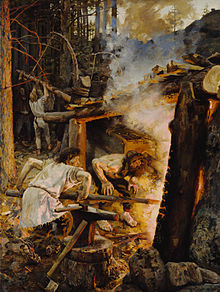
Those who speak the same language are joined to each other by a multitude of invisible bonds by nature herself, long before any human art begins; they understand each other and have the power of continuing to make themselves understood more and more clearly; they belong together and are by nature one and an inseparable whole. ...Only when each people, left to itself, develops and forms itself in accordance with its own peculiar quality, and only when in every people each individual develops himself in accordance with that common quality, as well as in accordance with his own peculiar quality—then, and then only, does the manifestation of divinity appear in its true mirror as it ought to be.
This view of nationalism inspired the collection of folklore by such people as the Brothers Grimm, the revival of old epics as national, and the construction of new epics as if they were old, as in the Kalevala, compiled from Finnish tales and folklore, or Ossian, where the claimed ancient roots were invented. The view that fairy tales, unless contaminated from outside literary sources, were preserved in the same form over thousands of years, was not exclusive to Romantic Nationalists, but fit in well with their views that such tales expressed the primordial nature of a people. For instance, the Brothers Grimm rejected many tales they collected because of their similarity to tales by Charles Perrault, which they thought proved they were not truly German tales; Sleeping Beauty survived in their collection because the tale of Brynhildr convinced them that the figure of the sleeping princess was authentically German.
Romanticism played an essential role in the national awakening of many Central European peoples lacking their own national states, not least in Poland, which had recently lost its independence when Russia's army crushed the Polish Rebellion under Nicholas I. Revival and reinterpretation of ancient myths, customs and traditions by Romantic poets and painters helped to distinguish their indigenous cultures from those of the dominant nations and crystallise the mythography of Romantic nationalism. Patriotism, nationalism, revolution and armed struggle for independence also became popular themes in the arts of this period. Arguably, the most distinguished Romantic poet of this part of Europe was Adam Mickiewicz, who developed an idea that Poland was the Messiah of Nations, predestined to suffer just as Jesus had suffered to save all the people.
Gallery
-
Joseph Vernet, 1759, Shipwreck , Groeninge Museum, Bruges
-
James Ward, 1814-1815, Gordale Scar
-
John Constable, 1821, The Hay Wain
-
J. C. Dahl, 1826, Outbreak of the Vesuvius, Städelsches Kunstinstitut, Frankfurt am Main
-
J. M. W. Turner, The Burning of the Houses of Lords and Commons (1835), Philadelphia Museum of Art
-
George Caleb Bingham, c. 1845, Fur traders on the Missouri River
-
Frederic Edwin Church, 1860, Twilight in the Wilderness, Cleveland Museum of Art
-
Albert Bierstadt, 1863, The Rocky Mountains: Lander's Peak
-
Samuel Palmer, c.1864, A Dream in the Apennine Tate Britain
See also
Related termsOpposing terms |
Related subjects |
Related movements |
Romantic scholars
|
References
- ^ Romanticism. Retrieved 30 January 2008, from Encyclopædia Britannica Online
- ^ Casey, Christopher (October 30, 2008). ""Grecian Grandeurs and the Rude Wasting of Old Time": Britain, the Elgin Marbles, and Post-Revolutionary Hellenism". Foundations. Volume III, Number 1. Retrieved 2009-06-25.
- ^ David Levin, History as Romantic Art: Bancroft, Prescott, and Parkman (1967)
- ^ Gerald Lee Gutek, A history of the Western educational experience (1987) ch. 12 on Johann Heinrich Pestalozzi
- ^ Ashton Nichols, "Roaring Alligators and Burning Tygers: Poetry and Science from William Bartram to Charles Darwin," Proceedings of the American Philosophical Society 2005 149(3): 304-315
- ^ "'A remarkable thing,' continued Bazarov, 'these funny old romantics! They work up their nervous system into a state of agitation, then, of course, their equilibrium is upset.'" (Ivan Turgenev, Fathers and Sons, chap. 4 [1862])
- ^ Baudelaire's speech at the "Salon des curiosités Estethiques
- ^ For a detailed discussion of its musical manifestations, see musical nationalism.
- ^ Inherited from the galante pre-Classical style.
- ^ Walter Friedlaender, From David to Delacroix, 1974, remains the best available account of the subject.
Bibliography
- Abrams, Meyer H. (1971). The Mirror and the Lamp. London: O. U. P. ISBN 0195014715.
- Abrams, M.H., Natural Supernaturalism: Tradition and Revolution in Romantic Literature (New York: W.W. Norton, 1973).
- Berlin, Isaiah (1999). The Roots of Romanticism. London: Chatto & Windus. ISBN 0691086621.
- Marcel, Brion (1966). Art of the Romantic Era. Henry Holt & Company, Inc. ISBN 0275420906.
- Ciofalo, John J. "The Ascent of Genius in the Court and Academy." The Self-Portraits of Francisco Goya. Cambridge University Press, 2001.
- Fay,Elizabeth, Romantic Medievalism. History and the Romantic Literary Ideal. Houndsmills, Basingstoke: Palgrave, 2002.
- Friedlaender, Walter, David to Delacroix, (Originally published in German; reprinted 1980) 1952.
- Gillespie, Gerald / Manfred Engel / Bernard Dieterle (eds.), Romantic Prose Fiction (= A Comparative History of Literatures in European Languages, Bd. XXIII; ed. by the International Comparative Literature Association). Amsterdam, Philadelphia: John Benjamins 2008, pp. 263–295. ISBN 978-9027234568.
- Holmes, Richard. The Age of Wonder: The Romantic Generation and the Discovery of the Beauty and Terror of Science (2009) ISBN: 978-1-4000-3187-0
- Honour, Hugh, Romanticism, (Westview Press) 1979.
- Lim, Cwisfa, Romanticism - The dawn of a new era, 2002. (reprinted 2006)
- Masson, Scott, 'Romanticism', Ch.7 in The Oxford Handbook of English Literature and Theology, (Oxford University Press) 2007.
- Murray, Christopher, ed. Encyclopedia of the romantic era, 1760-1850 (2 vol 2004); 850 articles by experts; 1600pp
- Novotny, Fritz, Painting and Sculpture in Europe, 1780-1880, 1971. (2nd edition 1980)
- Rosenblum, Robert, Modern Painting and the Northern Romantic Tradition: Friedrich to Rothko, (Harper & Row) 1975.
- Tekiner, Deniz, Modern Art and the Romantic Vision, (University Press of America) 2000.
- Workman, Leslie J., "Medievalism and Romanticism," Poetica 39–40 (1994): 1–34.
External links
- Romantic Circles Electronic editions, histories, and scholarly articles related to the Romantic era
- The Romantic Poets
- Dictionary of the History of Ideas, Romanticism
- Dictionary of the History of Ideas, Romanticism in Political Thought







